|
| |
Jazz Cello
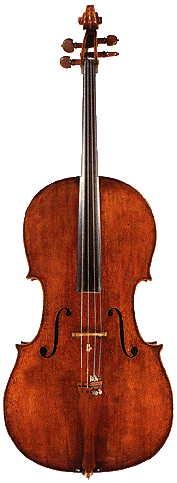 The
violoncello or cello is the tenor voice in the string family. While
shaped like a violin, the cello is much larger and is held between the player’s
knees. Because it can produce beautiful sounds from its lowest to its highest
notes, it is a popular instrument. The
violoncello or cello is the tenor voice in the string family. While
shaped like a violin, the cello is much larger and is held between the player’s
knees. Because it can produce beautiful sounds from its lowest to its highest
notes, it is a popular instrument.
By 1529 a 3-stringed instrument was made,
probably in Italy. About a century later it was called "violincello", which is
Italian for "small double bass". That is what we get the word "cello" from. Late
in the 1600’s, composers began writing music for the cello. It played the bass
in the early days of the
string quartet,
only occasionally taking the melody. It became distinct in symphony orchestras
and in chamber
music in the 1700’s and 1800’s. The cello was used for many years to
strengthen the bass section of church choirs.
The cello is the second largest of the string
section. It is the
tenor or
baritone of
the string family. The notes have a deep, warm tone. Of all the strings, the
rich, singing sound of the cello make it sound the most like a human voice. Some
people believe it is the most expressive instrument in the orchestra. In string
quartets the cello usually plays the lowest notes. The cello is played with a
bow or plucked
(pizzicato).
It is about 4 feet tall, approximately 1-1/2 feet across, and weighs 22 pounds.
The thicker and longer strings of the cello make it a whole octave deeper than
the viola.
Erik
Friedlander Jazz Cello Lessons
Erik Friedlander is one of the world' most accomplished cellists who has
hypnotized audiences with his astonishing solo recitals.
A virtuosic veteran of New York’s downtown scene, Friedlander is a composer and
an improviser, a classical musician and a jazz lover. He has always worked to
stake out new ground for the cello in both his compositional choices and his
dynamic improvising style.
He is a member of Masada and ongoing collaborator with John Zorn, Laurie
Anderson and many others. He has released a series of acclaimed releases on
Tzadik including Volac: Booking of Angels. His latest release is the stunning
Black Ice and Propane (Brassland). He also leads the groups Topaz, Broken Arm
and Grains of Paradise.
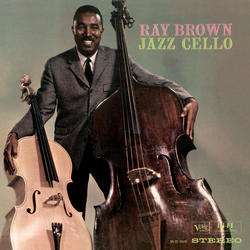 Master
bass player Ray Brown turned his attention to the cello on this 1960
recording. "I think it's a wonderful means of expression because it contains the
lower range of a guitar and and the higher range of a bass," Brown said of his
second instrument, "It allows you to create elaborately and fast." This album
showcases a rarely heard aspect of Ray Brown's artistry Master
bass player Ray Brown turned his attention to the cello on this 1960
recording. "I think it's a wonderful means of expression because it contains the
lower range of a guitar and and the higher range of a bass," Brown said of his
second instrument, "It allows you to create elaborately and fast." This album
showcases a rarely heard aspect of Ray Brown's artistry
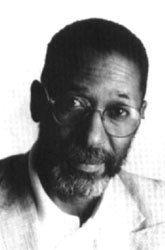 Ron
Carter The epitome of class and
elegance, though not stuffy, Ron Carter has been a world class bassist and
cellist since the '60s. He's among the greatest accompanists of all time, but
has also done many albums exhibiting his prodigious technique. He's a brilliant
rhythmic and melodic player, who uses everything in the bass and cello arsenal;
walking lines, thick, full, prominent notes and tones, drones and strumming
effects, and melody snippets. His bowed solos are almost as impressive as those
done with his fingers. Carter has been featured in clothing, instrument, and
pipe advertisements; he's close to being the bass equivalent of a
Duke Ellington in his mix of musical and extra-musical interests. Carter's
nearly as accomplished in classical music as jazz, and has performed with
symphony orchestras all over the world. He's almost exclusively an acoustic
player; he did play electric for a short time in the late '60s and early '70s,
but hasn't used it in many, many years. Carter began playing cello at ten. But
when his family moved from Ferndale, MI, to Detroit, Carter ran into problems
with racial stereotypes regarding the cello and switched to bass. He played in
the Eastman School's Philharmonic Orchestra, and gained his degree in 1959. He
moved to New York and played in
Chico Hamilton's quintet with
Eric Dolphy, while also enrolling at the Manhattan School of Music. Carter
earned his master's degree in 1961. After
Hamiliton returned to the West Coast in 1960, Carter stayed in New York and
played with
Dolphy and
Don Ellis, cutting his first records with them. He worked with
Randy Weston and
Thelonious Monk, while playing and recording with
Jaki Byard in the early '60s. Carter also toured and recorded with
Bobby Timmons' trio, and played with
Cannonball Adderley. He joined
Art Farmer's group for a short time in 1963, before he was tapped to become
a member of
Miles Davis' band. Carter remained with
Davis until 1968, appearing on every crucial mid-'60s recording and teaming
with
Herbie Hancock and
Tony Williams Ron
Carter The epitome of class and
elegance, though not stuffy, Ron Carter has been a world class bassist and
cellist since the '60s. He's among the greatest accompanists of all time, but
has also done many albums exhibiting his prodigious technique. He's a brilliant
rhythmic and melodic player, who uses everything in the bass and cello arsenal;
walking lines, thick, full, prominent notes and tones, drones and strumming
effects, and melody snippets. His bowed solos are almost as impressive as those
done with his fingers. Carter has been featured in clothing, instrument, and
pipe advertisements; he's close to being the bass equivalent of a
Duke Ellington in his mix of musical and extra-musical interests. Carter's
nearly as accomplished in classical music as jazz, and has performed with
symphony orchestras all over the world. He's almost exclusively an acoustic
player; he did play electric for a short time in the late '60s and early '70s,
but hasn't used it in many, many years. Carter began playing cello at ten. But
when his family moved from Ferndale, MI, to Detroit, Carter ran into problems
with racial stereotypes regarding the cello and switched to bass. He played in
the Eastman School's Philharmonic Orchestra, and gained his degree in 1959. He
moved to New York and played in
Chico Hamilton's quintet with
Eric Dolphy, while also enrolling at the Manhattan School of Music. Carter
earned his master's degree in 1961. After
Hamiliton returned to the West Coast in 1960, Carter stayed in New York and
played with
Dolphy and
Don Ellis, cutting his first records with them. He worked with
Randy Weston and
Thelonious Monk, while playing and recording with
Jaki Byard in the early '60s. Carter also toured and recorded with
Bobby Timmons' trio, and played with
Cannonball Adderley. He joined
Art Farmer's group for a short time in 1963, before he was tapped to become
a member of
Miles Davis' band. Carter remained with
Davis until 1968, appearing on every crucial mid-'60s recording and teaming
with
Herbie Hancock and
Tony Williams
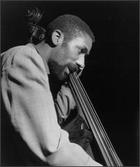 to
craft a new, freer rhythm section sound. The high profile job led to the
reputation that's seen Carter become possibly the most recorded bassist in jazz
history. He's been heard on an unprecedented
number of recordings; some sources claim 500, others have estimated it to be as
many as 1,000. The list of people he's played with is simply too great to be
accurately and completely cited. Carter's been a member of New York Jazz Sextet
and
New York Jazz Quartet, V.S.O.P. Tour, Milestone Jazzstars,and was in one of
the groups featured in the film Round Midnight in 1986. He's led his own bands
at various intervals since 1972, using a second bassist to keep time and
establish harmony so he's free to provide solos. Carter even invented his own
instrument, a piccolo bass. Carter's also contributed many arrangements and
compositions to both his groups and other bands. He's done duo recordings with
either
Cedar Walton or
Jim Hall. Carter's recorded for Embryo/Atlantic, CTI, Milestone, Timeless,
EmArcy, Galaxy, Elektra, and Concord, eventually landing at Blue Note for LPs
including 1997's The Bass and I, 1998's So What?, and 1999's
Orfeu.
When Skies Are Grey surfaced in early 2001. to
craft a new, freer rhythm section sound. The high profile job led to the
reputation that's seen Carter become possibly the most recorded bassist in jazz
history. He's been heard on an unprecedented
number of recordings; some sources claim 500, others have estimated it to be as
many as 1,000. The list of people he's played with is simply too great to be
accurately and completely cited. Carter's been a member of New York Jazz Sextet
and
New York Jazz Quartet, V.S.O.P. Tour, Milestone Jazzstars,and was in one of
the groups featured in the film Round Midnight in 1986. He's led his own bands
at various intervals since 1972, using a second bassist to keep time and
establish harmony so he's free to provide solos. Carter even invented his own
instrument, a piccolo bass. Carter's also contributed many arrangements and
compositions to both his groups and other bands. He's done duo recordings with
either
Cedar Walton or
Jim Hall. Carter's recorded for Embryo/Atlantic, CTI, Milestone, Timeless,
EmArcy, Galaxy, Elektra, and Concord, eventually landing at Blue Note for LPs
including 1997's The Bass and I, 1998's So What?, and 1999's
Orfeu.
When Skies Are Grey surfaced in early 2001.
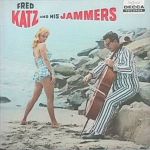 Fred
Katz Fred
Katz
Fred Katz's cello playing with the Chico
Hamilton Quintet during 1955-1958 was largely responsible for the popular cool
jazz group's unique sound and atmospheric style. Katz was classically trained
(he had studied with Pablo Casals) and worked in orchestras, but also played
piano. In the early '50s, he accompanied several singers, including Lena Horne
and Tony Bennett. While with Hamilton, Katz also recorded several albums of his
own for Pacific Jazz, Decca, and Warner Bros. (1956-1958). After leaving Chico
(with whom he recorded one final set in 1959), Katz mostly worked outside of
jazz, both in classical music and as a professor in anthropology. In 1989, he
was part of a Chico Hamilton Quintet reunion, recording for Soul Note and
showing that he was still a masterful musician.
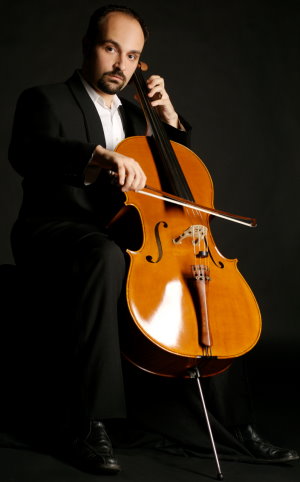 Lucio
Amanti - Jazz Cello Born
in Montreal Canada, he grew up and begun his studies in Cello and Composition in
Italy and France. After a few years of orchestra and chamber music experience,
he won a scholarship in 2004 that allowed him to enter the studio of the
legendary cellist Janos Starker at Indiana University in Bloomington for
a Performer Diploma degree. After two years of study he decided to explore
different approaches to cello playing, improving his already strong classical
preparation with two years of studies in the Jazz field with another musical
legend: Doctor David N. Baker, becoming the first cellist at Indiana University
ever to achieve a Master degree in Jazz studies. Lucio
Amanti - Jazz Cello Born
in Montreal Canada, he grew up and begun his studies in Cello and Composition in
Italy and France. After a few years of orchestra and chamber music experience,
he won a scholarship in 2004 that allowed him to enter the studio of the
legendary cellist Janos Starker at Indiana University in Bloomington for
a Performer Diploma degree. After two years of study he decided to explore
different approaches to cello playing, improving his already strong classical
preparation with two years of studies in the Jazz field with another musical
legend: Doctor David N. Baker, becoming the first cellist at Indiana University
ever to achieve a Master degree in Jazz studies.
After finishing his studies he
decided to dedicate his time to finding a personal balance between musical
tradition and experimental approaches. Mr. Amanti has recently finished his
first commercial album that has been in the I-tunes top ten sellers in the jazz
category in Italy. In this Album, the cello keeps the classical and jazz
inspirations constantly in balance using improvisation and the use of
electronics to create the illusion of a string ensemble, a percussion ensemble
or a rhythm section. He is also writing and recording film scores and designing
a series of shows that will feature the synergy between Cello/Electronics and
images projected and edited live during the performance.
He has performed and
collaborated with: Luis Bacalov, David N. Baker, Aldo Ciccolini, David
Sanchez, Ricardo Lorenz, Roberto De Simone and others.
Some have said about him:
I feel privileged to have had the opportunity to work with this fine young
man. (Dr. David N. Baker)
He is a serious, dedicated musician and I am convinced of his potential to
succeed. I strongly support his quest. (Dr. Janos Starker)
[…] He marks a very interesting
path to discover the enormous potential of an instrument typically classical,
very well used also into the Jazz (Marco Losavio www.jazzitalia.net)
 James
Hesford - UK Jazz Cellist James
Hesford - UK Jazz Cellist
began performing in his early teens as a blues and soul guitarist, touring the
UK and Europe.
At the age of 19 he moved from South Yorkshire to London where he established
himself as a leading jazz musician. In 1980 he won the Young Jazz Musician of
the Year Award with his own Quartet Channel 9 (Pete Jacobson - piano, Steve
Shone – bass, Colin Wilkinson – drums) and soon after moved to New York. In the
two years that followed he performed all styles of jazz from bebop to free
atonal improvisation as well as becoming involved in the loft scene and playing
in punk bands.
It was here that he developed his own voice as a composer/performer and a chance
meeting with producer John Leckie resulted in James returning to England to
record an album at EMI's Abbey Road Studios.
The project evolved into "Out Bar" (a nine piece ensemble) known for James'
innovative compositions and brass arrangement.
After a period of experimenting with new ideas for the cello James formed
Cellorhythmics (cello quartet and percussion) with the leading classical cellist
Alfia Nakipbekova (Bekova).
His vision for the Instrument as a jazz/ non-classical/improvising medium is
fully explored in this context
http://philharmoniker.web-feedback.de/index.asp
http://www.musicianspage.com/musicians-list/instrumentalists/cello/jazz.html
http://www.kyemarshall.com/profile.html
http://www.onoffon.com/harrythebear.html
http://www.cello.org/index.cfm?fuseaction=Home
http://www.violoncellosocietylondon.org/
 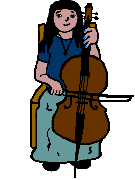
|